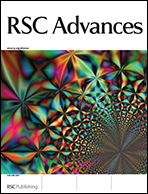A new fluorescent probe for monitoring amyloid fibrillation with high sensitivity and reliability†
Abstract
Amyloid fibrillation of peptides and proteins has been associated with a great variety of pathologic conditions. Development of new fluorescent molecules that can monitor amyloidosis kinetics is of great diagnostic and therapeutic significance. In this work, we report a new fluorescent probe, thiazole orange (TO), to track the amyloid fibril aggregation process, using hen egg-white lysozyme as a model protein. TO is virtually non-fluorescent when it is dissolved with native lysozyme in an incubation buffer, but it presents high fluorescence emission and its fluorescence intensity increases up to 400 times upon aggregation with lysozyme fibrils in incubation buffer for 14 days. The strong fluorescence enhancement observed upon binding of the TO to amyloid fibrils is attributed to the formation of intermolecular TO H-aggregates accompanied by the restriction of intramolecular rotation of TO. The sensitivity of the lysozyme aggregation assay with this new dye is higher than that of the classical amyloid biomarker thioflavin T (ThT), which only has a 50-fold enhancement in fluorescence intensity under the same conditions. Moreover, the presence of TO in the lysozyme incubation buffer does not perturb the rate of amyloid assembly. Our results demonstrate that TO can potentially be used as an in situ monitor for protein fibrillation with high sensitivity and reliability.


 Please wait while we load your content...
Please wait while we load your content...